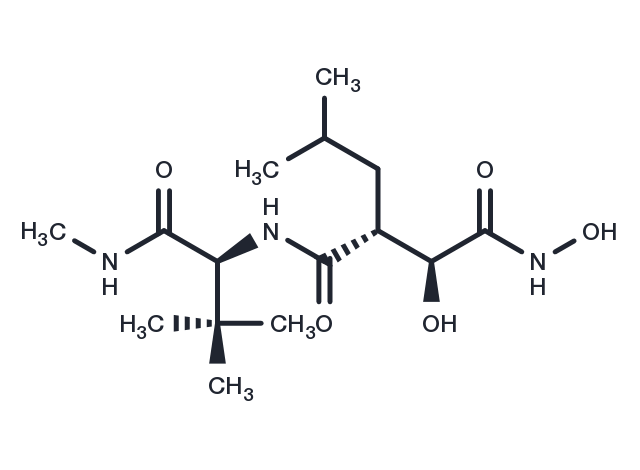Powder: -20°C for 3 years | In solvent: -80°C for 1 year


Marimastat (BB2516) (BB-2516) is a potent, broad spectrum matrix metalloprotease (MMP) inhibitor. MMP-9 (IC50=3 nM), MMP-1 (IC50=5 nM), MMP-2 (IC50=6 nM), MMP-14 (IC50=9 nM)and MMP-7 (IC50=13 nM).

| Pack Size | Availability | Price/USD | Quantity |
|---|---|---|---|
| 1 mg | In stock | $ 54.00 | |
| 5 mg | In stock | $ 85.00 | |
| 10 mg | In stock | $ 129.00 | |
| 25 mg | In stock | $ 229.00 | |
| 50 mg | In stock | $ 382.00 | |
| 100 mg | In stock | $ 562.00 | |
| 1 mL * 10 mM (in DMSO) | In stock | $ 61.00 |



| Description | Marimastat (BB2516) (BB-2516) is a potent, broad spectrum matrix metalloprotease (MMP) inhibitor. MMP-9 (IC50=3 nM), MMP-1 (IC50=5 nM), MMP-2 (IC50=6 nM), MMP-14 (IC50=9 nM)and MMP-7 (IC50=13 nM). |
| Targets&IC50 | MMP1:5 nM, MMP7:13 nM, MMP2:6 nM, MMP9:3 nM, MMP14:9 nM |
| In vitro | Marimastat (BB-2516) is a broad-spectrum MMPI with an enzyme inhibitory spectrum very similar to batimastat. [1] Marimastat inhibits CD30 shedding in Karpas 299 cells with an IC50 of 1 microM [2] and also inhibits LPS-induced soluble TNF-alpha production in a dose-dependent manner. The enzyme, tumor necrosis factor alpha convertase (TACE), reported to be closely related to matrix metalloproteinases, is responsible for the processing of pro-TNFalpha to TNFalpha and is specifically inhibited by Marimastat with an IC50 of 3.8 nM.[3] |
| In vivo | Marimastat has a favorable pharmacokinetic profile in humans, as it is almost completely absorbed after oral administration, with a high and predictable bioavailability and a half-life of approximately 15 hr (justifying twice a day dosing), making it a much more palatable treatment option for Clinicalal trials than batimastat. Marimastat is rapidly metabolized in rodents, undergoing a very high first-pass effect, making testing of marimastat in rodents difficult, as sustained plasma concentrations in this species are difficult to obtain. [1] |
| Kinase Assay | Compounds 1, 2, 7-9 and 11-16 are pre-incubated with MMP-1 or MMP-3 (10 nM) at different concentrations (0-10 μM) in a mixture of Tris-HCl (50 mM, pH 7.5), NaCl (150 mM), CaCl2 (10 mM), NaN3 (0.02%) and Brij-35 (0.05%) for 1 hour at 37°C. Residual activity is measured using the fluorogenic MMP substrate (2 μM) by fluorescence increase (emission at 393 nm and excitation at 325 nm) on a fluorescence plate reader. The data are fitted to the tight binding inhibitor equation: v=[(E-I-k+[(E-I-k)2+4Ek]1/2)/(2E)], where v is the velocity of the reaction, E is the enzyme concentration, I is the initial inhibitor concentration, and k is the apparent inhibition constant, using the software Prism. |
| Synonyms | BB2516, KB-R8898, TA2516 |
| Molecular Weight | 331.41 |
| Formula | C15H29N3O5 |
| CAS No. | 154039-60-8 |
Powder: -20°C for 3 years | In solvent: -80°C for 1 year
DMSO: 33.1 mg/mL (100 mM)
You can also refer to dose conversion for different animals. More
bottom
Please see Inhibitor Handling Instructions for more frequently ask questions. Topics include: how to prepare stock solutions, how to store products, and cautions on cell-based assays & animal experiments, etc.
Marimastat 154039-60-8 Proteases/Proteasome MMP BB-2516 KB-R 8898 TA 2516 inhibit BB2516 TA-2516 Inhibitor KB-R8898 TA2516 BB 2516 KB-R-8898 Matrix metalloproteinases inhibitor
